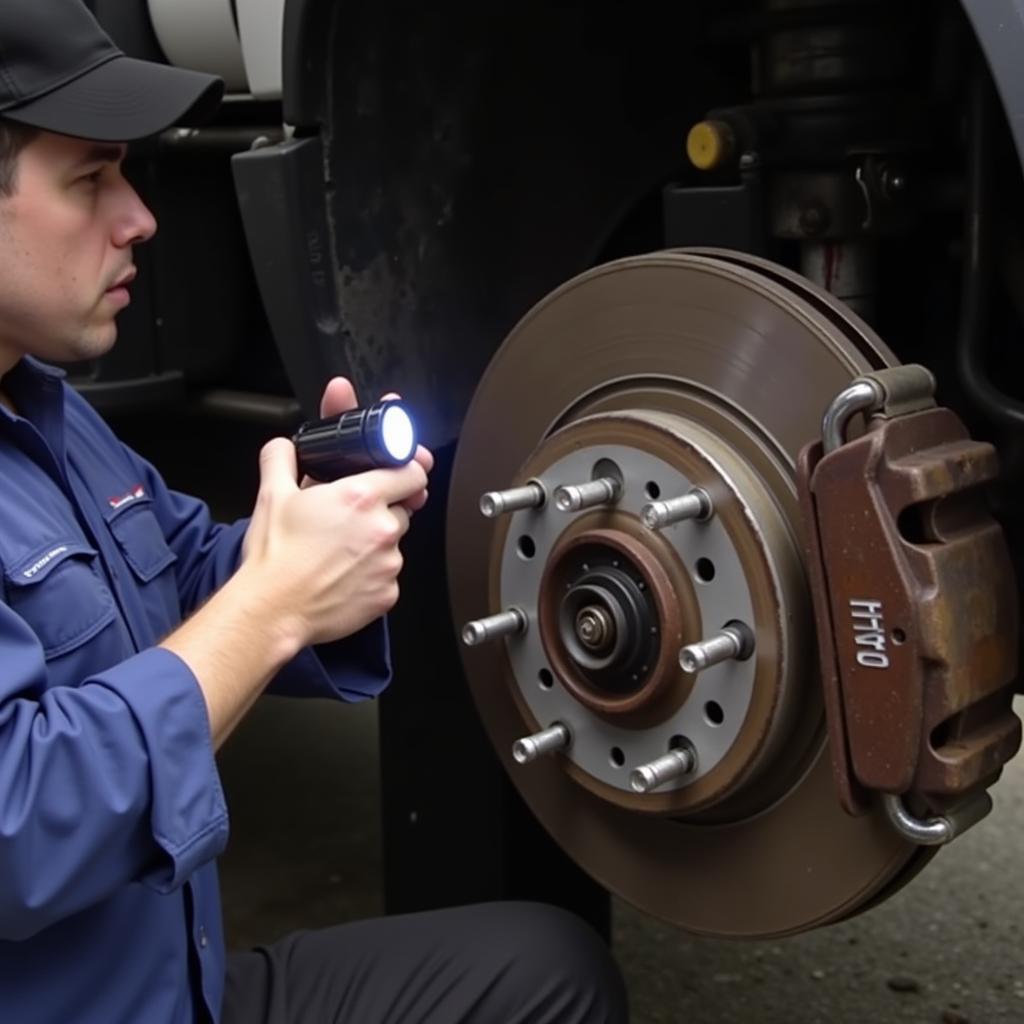The dreaded chevy c5500 brake warning light can be a source of anxiety for any driver. This light signifies a potential issue with your braking system, which is critical for safe operation. Whether you’re experiencing a soft pedal, grinding noises, or simply the persistent glow of the warning light, understanding the causes and solutions can help you get back on the road safely and confidently. This guide will provide comprehensive troubleshooting steps, potential causes, and solutions for addressing your chevy c5500 brake warning light concerns.
Understanding the Chevy C5500 Brake System
Before diving into troubleshooting, it’s helpful to have a basic understanding of your C5500’s braking system. These medium-duty trucks typically employ a hydraulic braking system, meaning brake fluid pressure is used to activate the brakes. Key components include the master cylinder, brake lines, calipers (for disc brakes), wheel cylinders (for drum brakes), and the brake pads or shoes themselves. The brake warning light is designed to illuminate when there’s a problem within this system.
Common Causes of a Chevy C5500 Brake Warning Light
There are several reasons why your chevy c5500 brake warning light might be on. Low brake fluid is one of the most common culprits. A leak in the system or worn brake pads can deplete the fluid level, triggering the warning light. Other potential causes include a faulty brake sensor, a malfunctioning ABS (Anti-lock Braking System), or issues with the parking brake.
 Chevy C5500 Low Brake Fluid Level Check
Chevy C5500 Low Brake Fluid Level Check
Troubleshooting the Brake Warning Light
If your chevy c5500 brake warning light comes on, the first step is to check the brake fluid level. Locate the master cylinder reservoir, typically found under the hood on the driver’s side. If the fluid is low, add brake fluid that meets the manufacturer’s specifications. Be sure to check for leaks if you frequently have to top up the fluid.
Checking for Leaks
Inspect the brake lines, calipers, and wheel cylinders for any signs of leakage. Look for wet spots or drips on the components or on the ground beneath them. A leak requires immediate attention and professional repair.
Inspecting Brake Pads and Shoes
Worn brake pads or shoes can also trigger the warning light. Inspect the pads or shoes for excessive wear. If they are thin or worn down, they need to be replaced.
ABS System Check
If your C5500 is equipped with ABS, a malfunctioning system can illuminate the brake warning light. A diagnostic scan tool can be used to retrieve ABS-related fault codes.
Remote Diagnostics and Programming for Chevy C5500 Brake Issues
Modern technology allows for remote diagnostics and programming, which can be incredibly beneficial for addressing chevy c5500 brake warning light issues. Trained technicians can remotely access your vehicle’s computer system, diagnose the problem, and even reprogram certain modules to resolve software-related issues.
“Remote diagnostics can save valuable time and money,” says John Miller, a Senior Automotive Diagnostic Technician. “It allows us to quickly pinpoint the problem and determine the best course of action, often without the need for a physical visit to the shop.”
When to Seek Professional Help
While some brake issues can be addressed with basic troubleshooting, others require professional expertise. If you’re unsure about the cause of your chevy c5500 brake warning light, or if you’re uncomfortable working on your brakes, it’s best to take your vehicle to a qualified mechanic. “Brakes are a critical safety system, and it’s never a good idea to take chances,” adds Miller. “If you’re in doubt, seek professional help.”
Conclusion
Addressing a chevy c5500 brake warning light promptly is crucial for maintaining safe driving conditions. By understanding the potential causes and employing the troubleshooting steps outlined in this guide, you can take the necessary steps to resolve the issue and get back on the road with confidence. Remember, regular brake maintenance and inspections are key to preventing future problems and ensuring optimal braking performance.
FAQ
- What should I do if my chevy c5500 brake warning light comes on while driving? Pull over safely as soon as possible and check your brake fluid level. If it’s low, add fluid if available. If the light remains on, have the vehicle towed to a mechanic.
- Can I drive my C5500 with the brake warning light on? It’s strongly discouraged. Driving with a brake warning light could be dangerous. Have the issue addressed as soon as possible.
- How often should I check my brake fluid level? Check your brake fluid level at least once a month as part of your regular vehicle maintenance.
- How often should I have my brakes inspected? It’s generally recommended to have your brakes inspected every 12,000 miles or once a year, whichever comes first.
- What does it mean if my brake pedal feels soft? A soft brake pedal can indicate low brake fluid, air in the brake lines, or a problem with the master cylinder.
- What are the signs of a brake fluid leak? Look for wet spots or drips on brake lines, calipers, wheel cylinders, and the ground beneath the vehicle.
- Can worn brake pads cause the brake warning light to come on? Yes, worn brake pads can trigger the warning light, especially in newer vehicles equipped with wear sensors.
